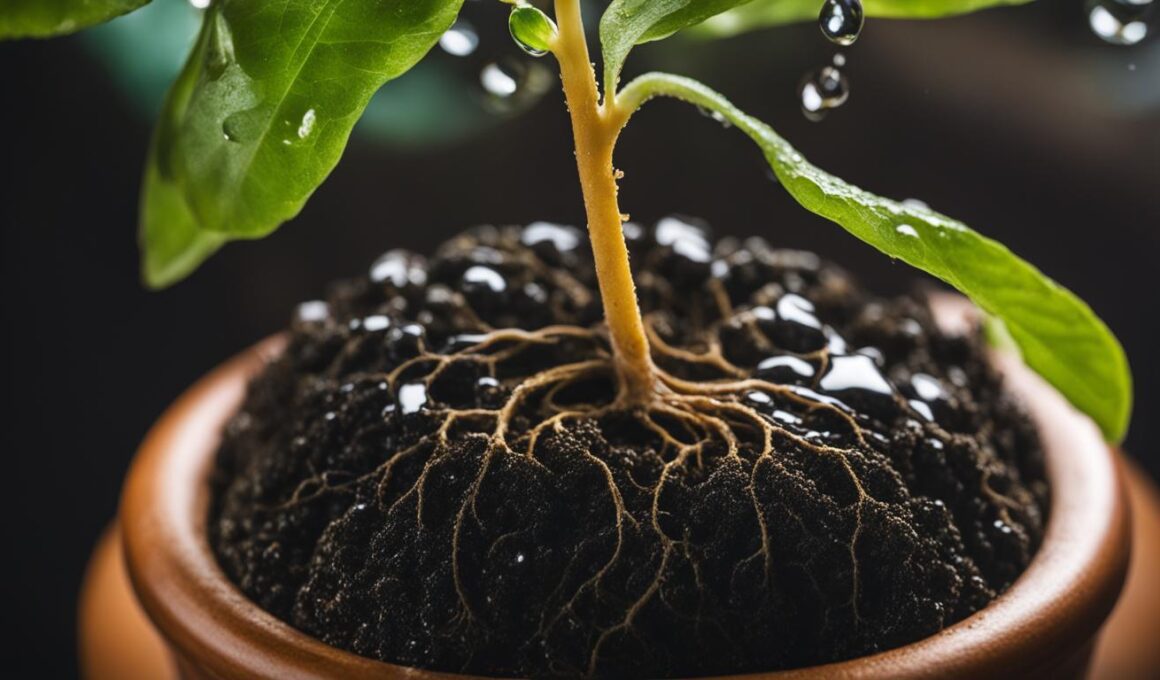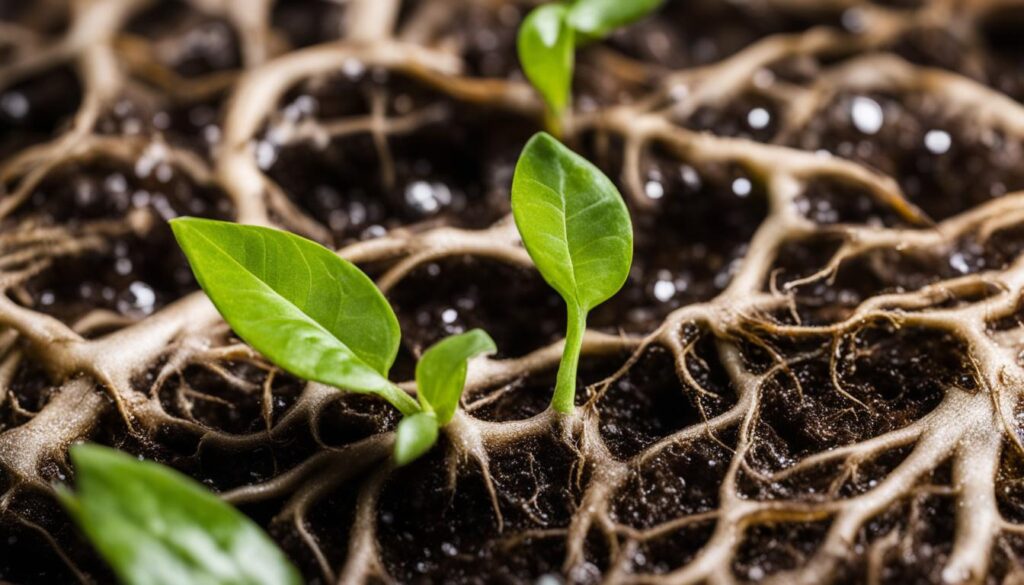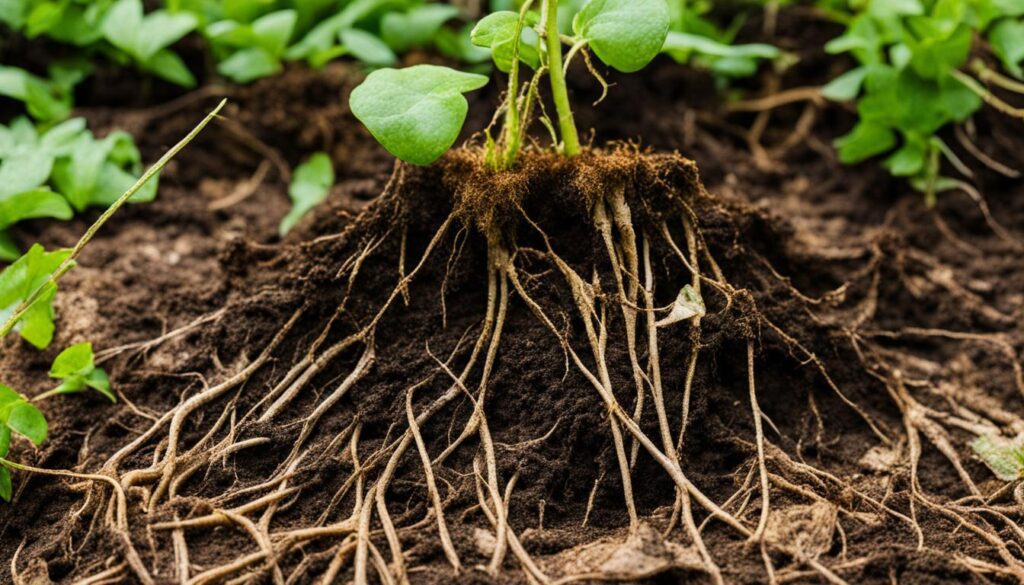If you’re struggling with root rot in your plants, don’t worry – there’s a solution. Hydrogen peroxide can be an effective treatment for root rot, helping to revive your plants and promote their overall health. In this article, we’ll explore how to properly use hydrogen peroxide to treat root rot and restore your plants to their vibrant state.
Key Takeaways:
- Root rot can be detrimental to the health of your plants, but hydrogen peroxide can help treat and eliminate the fungal pathogens causing the condition.
- By improving soil drainage and aeration, hydrogen peroxide promotes healthier root growth and overall plant vitality.
- It’s important to properly dilute the hydrogen peroxide solution and take precautions when using it, such as wearing gloves and safety goggles.
- Recognizing the symptoms of root rot and taking prompt action is crucial for saving your plants and preventing further damage.
- Using hydrogen peroxide is a natural, affordable, and accessible treatment option for root rot that can revive your plants and restore their beauty.
Understanding Root Rot and Its Symptoms
Root rot is a common plant disease that can have devastating effects on the health and vitality of your plants. It is caused by various factors, including overwatering, poor drainage, compacted soil, and lack of oxygen. Recognizing the symptoms of root rot is crucial in identifying and treating the condition before it leads to plant death.
The symptoms of root rot can vary depending on the plant species, but some common signs to look out for include discolored leaves, wilting, poor growth, early leaf drop, and branch decline. Discolored leaves, such as yellow, brown, or black, are often one of the first indicators of root rot. Wilting and poor growth are also common symptoms, as the disease impacts the plant’s ability to absorb water and nutrients from the soil. Early leaf drop and branch decline may occur as the disease progresses, eventually leading to the death of the plant if left untreated.
It is important to observe your plants regularly and take prompt action if you notice any of these symptoms. By understanding the signs of root rot, you can intervene early and implement necessary treatments to save your plants.
| Healthy Plants | Root Rot-Affected Plants |
|---|---|
| Green and vibrant leaves | Discolored leaves (yellow, brown, or black) |
| Sturdy stems and branches | Wilting and poor growth |
| Healthy root system | Roots that are brown, mushy, or have a foul odor |
| Continued growth and development | Early leaf drop and branch decline |
“By understanding the signs of root rot, you can intervene early and implement necessary treatments to save your plants.”
Recognizing and addressing root rot at its early stages can significantly increase the chances of saving your plants. In the next section, we will explore how hydrogen peroxide can be used as an effective treatment for root rot and help restore the health of your plants.
Hydrogen Peroxide as a Treatment for Root Rot
Hydrogen peroxide is a versatile and effective treatment for root rot in plants. When applied to the soil, hydrogen peroxide helps eliminate the fungal pathogens responsible for root rot. It also aids in improving soil drainage and aeration, creating a healthier environment for root growth. The benefits of using hydrogen peroxide for root rot treatment are numerous.
- Effective against a wide range of plant diseases: Hydrogen peroxide is not only effective in treating root rot but also other plant diseases caused by fungal pathogens. It acts as a powerful oxidizer, destroying harmful microorganisms.
- Natural and safe compound: Hydrogen peroxide is composed of water and oxygen, making it a safe and environmentally friendly option for treating root rot. It biodegrades into oxygen and water, leaving no harmful residues behind.
- Affordable and easy to find: Hydrogen peroxide is readily available at most pharmacies and grocery stores at an affordable price point. It is a cost-effective treatment option for root rot, especially for plant enthusiasts on a budget.
While using hydrogen peroxide for root rot treatment offers numerous benefits, it is essential to take precautions. Safety measures should be followed to ensure its proper and effective use.
Precautions for Using Hydrogen Peroxide for Root Rot Treatment
When handling hydrogen peroxide, it is crucial to wear gloves and safety goggles to protect your skin and eyes. This helps prevent any potential irritations or injuries. It is also important to properly dilute the hydrogen peroxide solution to a 3% concentration with water. Using higher concentrations may harm the plants.
Avoid oversaturating the soil with the hydrogen peroxide solution, as it can damage the leaves. It is recommended to apply the solution evenly and avoid excessive use. Additionally, hydrogen peroxide should not be used on stressed or unhealthy plants, as it may further weaken them.
Proper storage and handling are also essential. Keep hydrogen peroxide in a cool, dark place, away from children and pets to prevent accidents. If contact occurs with the skin or eyes, rinse thoroughly with water and seek medical attention if necessary.
By following the proper precautions and guidelines, hydrogen peroxide can be a highly effective treatment for root rot, restoring the health and vitality of your plants.
How to Use Hydrogen Peroxide Solution for Root Rot Treatment
If you’ve identified root rot in your plants, using hydrogen peroxide can be an effective treatment method. Here are the steps to follow:
- Begin by removing the affected plant from its container and gently rinsing off the soil from its roots. This will help you assess the extent of the root rot.
- Inspect the roots for signs of rot, such as discoloration or mushiness. Using sterilized scissors, carefully remove any dead or brown roots.
- Next, transplant the plant into a new potting mix or back into the same soil, once it dries completely.
- To prepare the hydrogen peroxide solution, mix one tablespoon of hydrogen peroxide (3% concentration) with one cup of water. This solution is safe for both the plants and you.
- Drench the soil thoroughly with the hydrogen peroxide solution, making sure not to oversaturate it. This will help kill the fungal pathogens responsible for root rot.
- Alternatively, you can also spray the hydrogen peroxide solution around the roots before repotting or at your next watering.
By following these steps, you can effectively use hydrogen peroxide to treat root rot and revive your plants. Remember to take proper precautions, such as wearing gloves and safety goggles, to ensure your safety while handling hydrogen peroxide.
Causes of Root Rot
Root rot can be caused by various factors, all of which can compromise the health and vitality of your plants. Understanding these causes is crucial in preventing and addressing root rot effectively.
The primary cause of root rot is overwatering. When plants are consistently exposed to excessive moisture, the roots become waterlogged, leading to a lack of oxygen and creating an ideal environment for fungal growth. Poor drainage and compacted soil further exacerbate the problem by preventing excess water from escaping, trapping it around the roots.
In addition to overwatering and poor drainage, root rot can also occur due to a lack of oxygen. When the soil is compacted or saturated, the roots are deprived of the oxygen they need to thrive. This lack of oxygen weakens the roots, making them more susceptible to infection by fungal pathogens.
Poor soil nutrition can also contribute to the development of root rot. When plants do not receive adequate nutrients from the soil, their overall health and defense mechanisms are weakened, making them more vulnerable to diseases like root rot.
It is important to address these underlying causes to prevent root rot and maintain healthy plants. By addressing issues such as overwatering, poor drainage, compacted soil, and ensuring proper nutrition, you can create an environment that supports robust root growth and reduces the risk of root rot.
Benefits of Using Hydrogen Peroxide for Root Rot Treatment
Using hydrogen peroxide for root rot treatment offers several benefits. One of the key advantages is that hydrogen peroxide acts as a powerful oxidizer, effectively killing the fungi responsible for root rot. By eliminating these pathogens, hydrogen peroxide helps to halt the progression of the disease and restore the health of your plants.
Additionally, hydrogen peroxide improves drainage and aeration in the soil. When applied to the root zone, it helps to break down compacted soil and allows for better water movement, reducing the risk of waterlogging and subsequent root rot. This improved drainage and aeration create a healthier environment for roots to thrive.
Another notable benefit of hydrogen peroxide as a root rot treatment is that it is a natural and safe compound. It breaks down into water and oxygen, minimizing any potential harm to plants or the environment. Furthermore, hydrogen peroxide is affordable and easy to find, making it a convenient option for treating root rot.
Summary:
- Hydrogen peroxide acts as a powerful oxidizer, killing the fungi responsible for root rot.
- It improves drainage and aeration in the soil, reducing the risk of waterlogging and subsequent root rot.
- Hydrogen peroxide is a natural and safe compound that breaks down into water and oxygen.
- It is an affordable and easily accessible treatment option for root rot.
Table: Comparison of Hydrogen Peroxide Treatment versus Traditional Methods
| Hydrogen Peroxide Treatment | Traditional Methods | |
|---|---|---|
| Effectiveness | Powerful oxidizer that kills root rot fungi effectively. | Dependent on the specific treatment used and may not be as effective at eliminating the fungi. |
| Drainage and Aeration Improvement | Enhances soil drainage and aeration, promoting healthier root growth. | Varies based on the method used, may not address the underlying issue causing root rot. |
| Safety | Natural and safe compound that does not harm plants or the environment. | May involve the use of chemical fungicides that have potential risks and environmental concerns. |
| Availability and Affordability | Readily available and affordable. | Dependent on the specific fungicide or treatment used. |
Using hydrogen peroxide for root rot treatment offers significant benefits in terms of effectiveness, drainage and aeration improvement, safety, and availability. Its powerful oxidizing properties effectively eliminate root rot fungi, promoting healthier root growth. Additionally, hydrogen peroxide improves soil drainage and aeration, creating an environment that discourages the development of root rot. It is a natural and safe compound that is easily accessible and affordable, making it a favorable choice for treating root rot compared to traditional methods.
Precautions for Using Hydrogen Peroxide for Root Rot Treatment
While hydrogen peroxide is generally safe to use for root rot treatment, it is important to take certain precautions to ensure its effective and safe application. By following these safety precautions, you can protect yourself, your plants, and achieve optimal results.
Proper Dilution
When using hydrogen peroxide for root rot treatment, it is crucial to dilute the solution properly. A 3% concentration is recommended for most plants. To achieve this, mix one tablespoon of hydrogen peroxide with one cup of water. Avoid using higher concentrations, as they can harm the plants.
Avoiding Oversaturation
While hydrogen peroxide can be beneficial in treating root rot, it is important not to oversaturate the soil with the solution. Too much hydrogen peroxide can damage the leaves and potentially harm the roots. Be cautious and apply the solution evenly without creating excess moisture in the soil.
Not for Stressed Plants
Hydrogen peroxide treatment is most effective when used on healthy plants. Avoid using hydrogen peroxide on stressed or unhealthy plants, as it may further weaken them. Focus on restoring the health of your plants before applying hydrogen peroxide for root rot treatment.
Storage and Handling Precautions
Proper storage and handling of hydrogen peroxide are essential for maintaining its effectiveness and safety. Store hydrogen peroxide in a cool, dark place away from direct sunlight. Keep it out of reach of children and pets to prevent any accidents. When handling hydrogen peroxide, wear gloves and safety goggles to protect your skin and eyes from potential irritation.
By following these precautions for using hydrogen peroxide, you can effectively treat root rot and restore the health of your plants. Remember to dilute the solution properly, avoid oversaturation, use it on healthy plants, and handle it with care. With these precautions in mind, hydrogen peroxide can be a valuable tool in your arsenal against root rot.
Can Peroxide Treatment also be Effective for Fighting Downey Mildew?
Yes, peroxide treatment can be an effective downey mildew solution. Spraying a mixture of hydrogen peroxide and water on infected plants can help control and prevent the spread of downy mildew. The antifungal properties of peroxide can effectively combat the mildew, promoting healthier plant growth.
Conclusion
Root rot can have detrimental effects on the health and vitality of your plants, but with the use of hydrogen peroxide treatment, you have an effective solution at your disposal. By applying a hydrogen peroxide solution to the soil, you can eliminate the fungal pathogens responsible for root rot and improve drainage and aeration, promoting healthier root growth.
Reviving your plants and ensuring their continued growth and beauty is within reach. By following the steps outlined in this article and taking precautions when using hydrogen peroxide, you can successfully treat root rot and save your plants from further damage.
Don’t let root rot rob you of healthy plants. Take action today and give your plants the care they deserve with the powerful and effective treatment of hydrogen peroxide.
FAQ
What is root rot?
Root rot is a plant disease that affects the roots of trees and plants growing in wet or humid soil. It is caused by factors such as overwatering, poor drainage, and compacted soil.
What are the symptoms of root rot?
The symptoms of root rot include discolored leaves (yellow, brown, or black), wilting, poor growth, early leaf drop, branch decline, and, if left untreated, eventual plant death.
How does hydrogen peroxide help in treating root rot?
Hydrogen peroxide kills the fungal pathogens responsible for root rot and improves soil drainage and aeration, promoting healthier root growth.
What are the benefits of using hydrogen peroxide for root rot treatment?
Some benefits of using hydrogen peroxide include its effectiveness against a wide range of plant diseases, its natural composition, affordability, ease of use, and safety for both plants and people.
How do I use hydrogen peroxide solution for root rot treatment?
First, remove the affected plant from its container and gently wash off the dirt from the roots. Check the roots for signs of rot and remove any dead or brown roots. Transplant the plant to a new potting mix or the same soil once it is completely dry. Prepare a 3% concentration hydrogen peroxide solution by mixing one tablespoon of hydrogen peroxide with one cup of water. Drench the soil with the solution, making sure not to oversoak it. You can also spray the hydrogen peroxide solution directly around the roots before repotting or at your next watering.
What are the causes of root rot?
Root rot can be caused by factors such as overwatering, poor drainage, compacted soil, lack of oxygen, and poor soil nutrition.
What are the benefits of using hydrogen peroxide for root rot treatment?
Using hydrogen peroxide for root rot treatment offers several benefits, including its effectiveness in killing the fungi causing root rot and improving soil drainage and aeration. It is a natural compound that is safe to use on plants, affordable, and readily available.
Are there any precautions for using hydrogen peroxide for root rot treatment?
Yes, it is important to wear gloves and safety goggles when handling hydrogen peroxide. Use a 3% concentration hydrogen peroxide solution and avoid using higher concentrations. Do not oversaturate the soil with the solution, and avoid using hydrogen peroxide on stressed or unhealthy plants. Proper storage in a cool, dark place is recommended, and keep hydrogen peroxide away from children and pets.
How effective is root rot peroxide treatment for healthy plants?
Root rot peroxide treatment using hydrogen peroxide can be highly effective in treating root rot and reviving the health of plants. It kills the fungus causing root rot and improves soil drainage, promoting healthier root growth.












